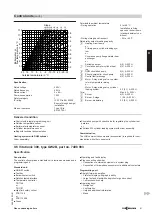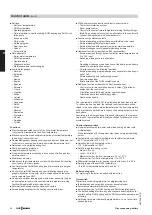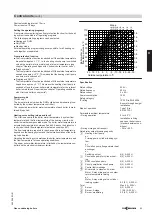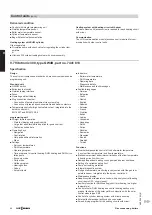
When engineering the system, observe the following:
■ Install shut-off valves in the different sections. This prevents the
need for draining all the heating water in the case of repairs or sys-
tem expansion.
■ In systems > 50 kW, install a water meter to record the amount of fill
and top-up water. Enter the volume of fill water and the water hard-
ness into the boiler service instructions.
■ For systems with a specific system volume in excess of 20 l/kW
heating output (in multi boiler systems apply the output of the small-
est boiler), apply the requirements of the next higher category of total
output (in accordance with the table). In the case of severe excess
(> 50 l/kW), soften the water down to a total of alkaline earths of
≤ 0.02 mol/m
3
For systems with system boilers with a total heating output < 50 kW
and total of alkaline earths in the fill and top-up water > 3.0 mol/m
3
,
implement one of the following measures:
■ Preferably soften the fill and top-up water.
■ Install a filter or separating facility in the heating flow.
Operating information:
■ Commission the system step by step, starting with the lowest boiler
output and a high heating water flow rate. This prevents a localised
concentration of limescale deposits on the boiler heating surfaces.
■ In multi boiler systems, start all boilers simultaneously to prevent the
entire limescale deposit settling in the heat transfer area of just one
boiler.
■ During expansion or repair work, only drain the necessary sections.
■ Where water treatment is required, treat even the first fill of the heat-
ing system prior to commissioning. This also applies to any subse-
quent filling, e.g. after repairs or after system expansion, and for all
amounts of top-up water.
■ Check, clean and activate filters, dirt traps and other blow-down or
separating facilities in the heating water circuit more frequently after
commissioning or new installations; later on do so subject to require-
ments in line with the water treatment applied (e.g. water softening).
The build-up of limescale deposits on the heating surfaces will be
minimised if these instructions are observed.
Any limescale deposits that have formed because of a failure to
observe the requirements to VDI Directive 2035 will in most cases
already have caused a reduction in the service life of the installed
heating equipment. Removing the limescale deposits is one option for
restoring operational viability. This measure must be carried out by a
specialist. Inspect the heating system for possible damage prior to
returning it into use. It is essential that the faulty operating parameters
are corrected to prevent excessive scale from forming again.
Prevention of damage through corrosion on the water side
The corrosion resistance of ferrous materials on the heating water side
of heating systems and heat generators depends on the absence of
oxygen in the heating water. The oxygen introduced into the heating
system with the first fill and subsequent top-ups reacts with the system
materials without causing damage.
The characteristic blackening of the water after a certain time in oper-
ation indicates that there is no more free oxygen present. The technical
rules and in particular VDI Guideline 2035-2 therefore recommend that
heating systems are designed and operated so that a constant ingress
of oxygen into the heating water is prevented.
During operation, oxygen can normally only enter due to:
■ Open expansion vessels receiving a flow
■ Negative pressure in the system
■ Gas-permeable components
Correctly sized sealed systems operating at the correct pressure –
e.g. systems with diaphragm expansion vessel – offer good protection
against the ingress of airborne oxygen into the system. In all operating
states and at all points in the heating system, including the intake side
of the pump, the pressure must be higher than the surrounding atmos-
pheric pressure. The pre-charge pressure of the diaphragm expansion
vessel should be checked at least during the annual service. See also
chapter 2.1 "General design information" for details regarding pres-
sure maintaining systems and corrosion. The use of permeable com-
ponents, e.g. permeable plastic pipes in underfloor heating systems,
should be avoided. Provide system separation if such components are
nevertheless used. This must separate the water flowing through the
plastic pipes from other heating circuits, e.g. from the boiler, by the
provision of a corrosion-resistant heat exchanger.
No further anti-corrosion measures are required for sealed hot water
heating systems, subject to the above points being observed. How-
ever, take additional precautions where there is a risk of oxygen
ingress, e.g. by adding oxygen binder sodium sulphite (5 - 10 mg/l into
the excess). The pH value of the heating water should be between 8.2
and 9.5.
Different conditions apply to systems that include aluminium compo-
nents.
Where chemicals are used as part of the corrosion protection, we rec-
ommend that the manufacturer of the chemicals issues a certificate of
suitability of the additives with regard to the boiler materials and the
materials of the other heating system components. We recommend
you refer questions regarding water treatment to an appropriate spe-
cialist.
Further details can be found in the VDI Guideline 2035-2.
8.11 Frost protection
An antifreeze additive suitable for heating systems can be added to
the fill water. The antifreeze manufacturer must verify its suitability,
since otherwise damage to gaskets and diaphragms can occur as well
as noise during heating operation. Viessmann accepts no liability for
any resulting damage or consequential losses.
Design information
(cont.)
Gas condensing boilers
VIESMANN
49
5822 449 GB
8
















































